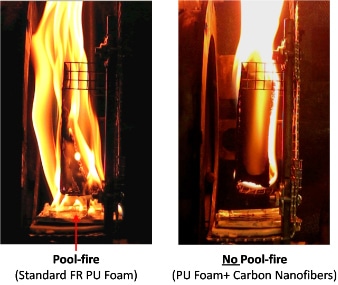Flame retardants are a class of chemicals designed to slow the spread of fire, particularly in fast-burning materials like textiles, wood and plastics.
The most common materials used as flame retardants are minerals like aluminium hydroxide or magnesium hydroxide, or heavily brominated organic compounds.
The market for flame retardants is growing rapidly, as the demand for potentially flammable consumer products increases in the emerging economies, and fire safety regulations grow stricter. Market forecasts predict that the global market for flame retardants will be worth nearly US$6 billion by 2018.
Environmental and Health Issues with Conventional Flame Retardants
There have been prevalent concerns about the environmental impact of brominated flame retardants for many years. They are known to be highly persistent in the environment, and to accumulate in the food chain, which exaccerbates their toxic effects.
Regulations controlling the use of these harmful compounds have led the chemical industry to develop alternative, halogen-free flame retardants. Initially, research was focused on phosphorous-based chemicals, but attention has also turned to nanomaterials, primarily exfoliated clays, as low-cost, high-performance flame retardant substances.
Nano-enabled flame retardants at NIST
Figure 1. This video from NIST demonstrates the effect of different flame retardants, including nanomaterials, on burning furniture.
Nanoclay Flame Retardants
Clay exists naturally in the form of platelets around a nanometre thick, stacked up to form particles on the oder of a few microns. Most of the beneficial properties of clay as a filler material are only realized when the particles are dispersed and exfoliated to separate the individual nanoscale layers - this is most often achieved by treatment with ultrasound.
Nanocomposites or polymers and exfoliated clays have been shown to exhibit excellent flame retardant properties. The spread of fire through the material is slowed, and dripping is reduced, which helps prevent the fire spreading to other objects nearby. The nanoclay also promotes formation of chars, which are thermally insulating and act as a barrier to flame propagation.
The most attractive propertie of clays, however, is that they are a completely natural material. This makes preprocessing much more straightforward, and there are very few environmental issues associated with disposal.
Carbon Nanotube Flame Retardants
Carbon nanotubes (CNTs) have also been investigated as potential flame retardant filler materials. They have been shown to reduce heat release in burning materials very effectively.
In particular, combining a low concentration of multi-wall CNTs with a nanoclay filler produces a synergistic effect that is much more effective than either component alone.
Despite the relatively high cost of manufacture for CNTs, the high performance of CNT-based flame retardants, and the low concentration required, could make this application viable, particularly for high-value areas such as cable insulation in data centres.

Figure 2. The effect of carbon nanofibre flame retardants on polyurethane foam. Dripping is reduced significantly, preventing the formation of the pool-fire, which would help slow the spread of fire in a real-world scenario. Image credit: NIST.gov
Conclusion
Nanomaterials have proved themselves to be highly effective flame retardants. Clays in particular deliver safer environmental profiles than the alternatives, as the material is completely natural to begin with.
The best performance seems to be gained from combining clays and nanofibres or nanotubes with other kinds of synthetic flame retardants like phosphorated organic compounds. This would mean that much less synthetic additive is needed, and less filler is needed in products overall, but care must still be taken to make sure that the health risks associated with the substances used are weighed against fire safety considerations.
References and Further Reading